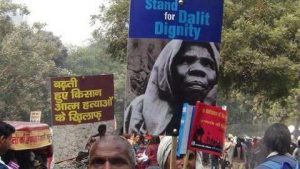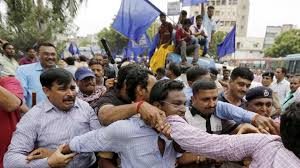
April 2 Dalit Demonstrations Mark The Beginning Of ‘Dalit Spring’
With the rise in atrocities being meted out to Dalit Community in India, the April 2 demonstrations were the reflection of the fraction of injustice meted out to the SC and ST people. To show their strength hundreds of thousands of India’s Dalits took to the streets across the country with the call for all-India-strike or Bharat Bandh. The call was made by the Dalit organisations and they were successful in proving their strength. The reason that compelled them to protest was that they were against the dilution of a law that was in actuality meant to protect them. The protests across the country were mostly peaceful – protesters blocked roads, participated in sit-ins and chanted slogans. But government forces and other right-wing groups were trying to silence there outcry. At some places they even opened fire at the demonstrators. Not less than 11 people are reported to have died due to the firing, mostly from the Dalit community.

The Bharat Bandh proved to be a turning point in India’s caste struggles. But for one to understand the importance and significance of this mass protest and all the reasons that made them to stand against government, it is necessary to analyse the current Indian government’s aggressive policiies and deep-seated hostile attitudes towards this particular group.
The Scheduled Castes (SC) and Scheduled Tribes (ST), if combined together constitute more than 20 percent of Indi’a population which may approximate upto 250 million people. For being the most underprivileged group in the country, they have always been the target of hate crimes and repeated discriminations in India. But their situation became worse only after the Bharatiya Janatha Party (BJP) came to power.

The ruling Bharatiya Janatha Party is the political face of the Hindu fundamentalist organization, Rashtriya Swayamsevak Sangh (RSS) in the Indian Democratic setup. The main purpose of the RSS is to transform India into a conservative Hindu state, so that all traditions of Hinduism, including the caste system and untouchability can be preserved. Despite the fact that they don’t openly express this idea, but they are against any form of social mobility and reform in the country.
Their main work is to protect the rights and privileges of the Brahmins, the Banias and the Ksahtriyas. They may raise issues of sacred things in the religion, but they remain silent on issues like abusing of Shudras, the Dalits and Adivasis in India.
Presently, the dalits are scared that the BJP and the RSS are attempting to dilute the system of reservations in India. The reservations system was made to protect the interests of the scheduled castes and tribes. Because of the system, they got their part easily in educational institutions, government jobs and even seats in the parliament and the state assemblies without any discrimination. These reservations and quotas are a method to justify what they deserve by birth.
And as the days passed by, this system helped underprivileged communities in India to be able to stand on their feet and claim their position in the society. With the help of these reservations, a small Dalit middle class emerged. But today we see that some members belonging to the “upper” castes are upset about the reservations system and success of this Dalit middle class.
(The above views were inspired by the article published by International-Qatar Based News Agency – Al Jazeera written by Kancha Ilaiah Shepherd of Hyderabad, India on 8 Apr 2018)